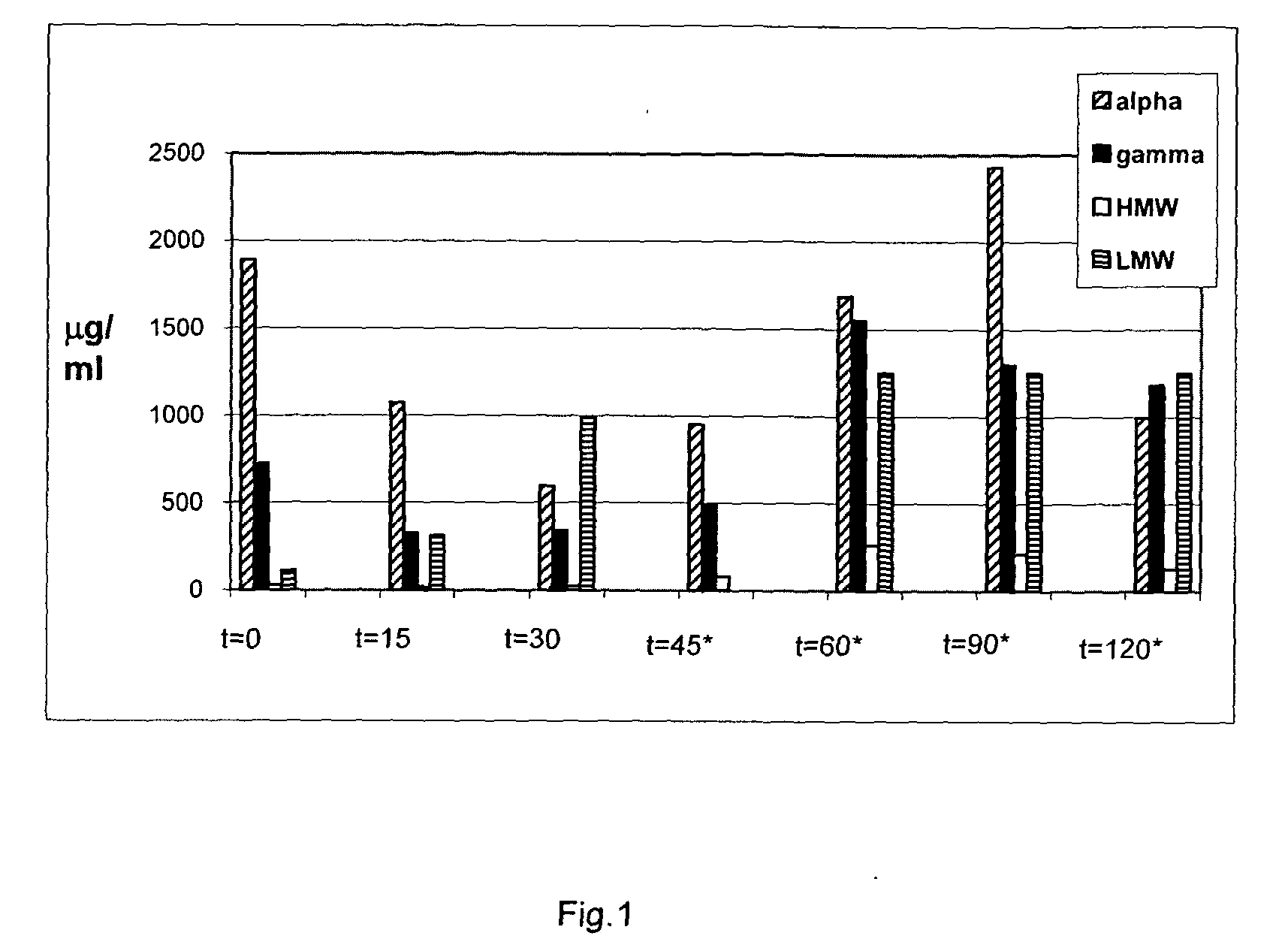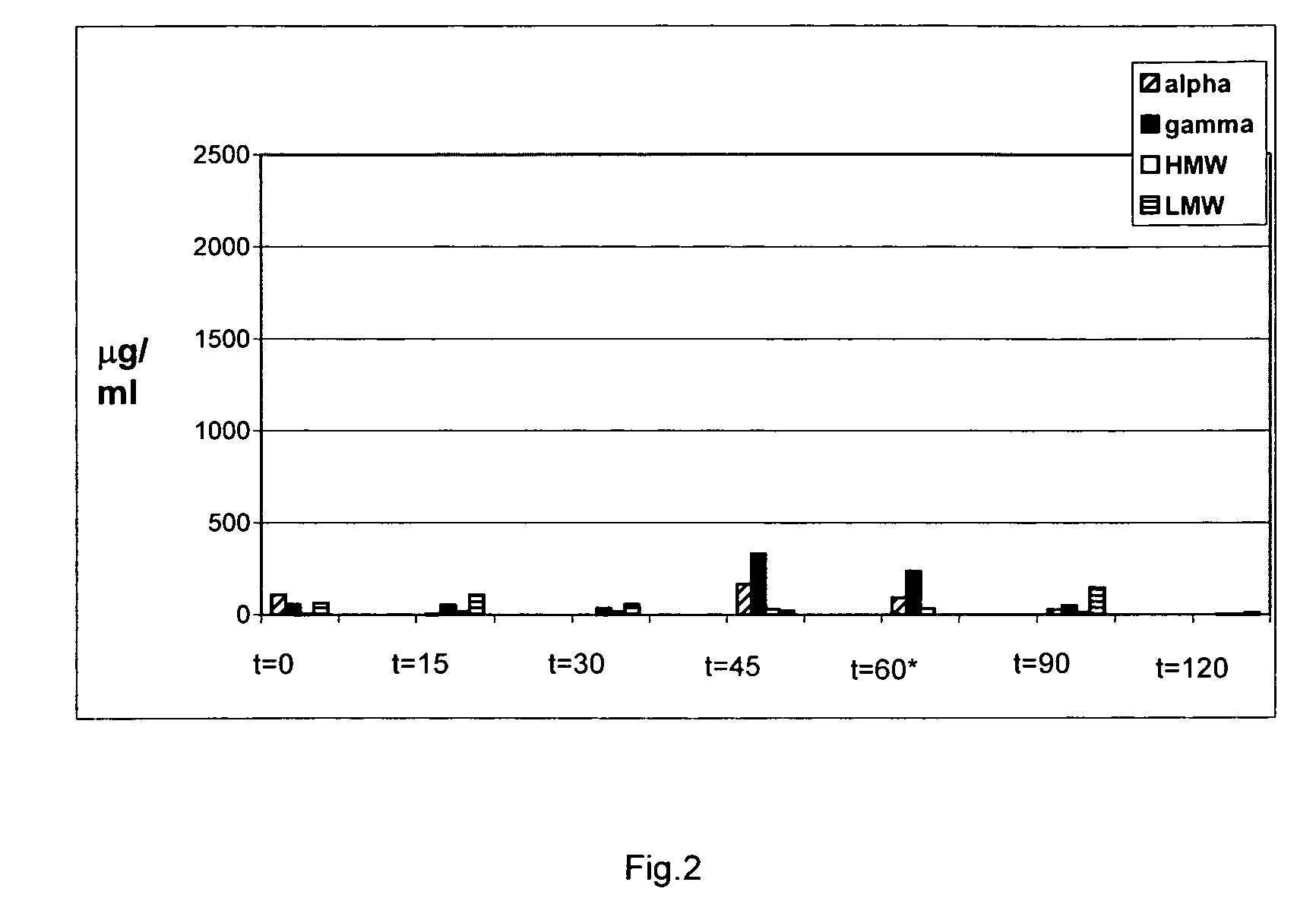Food product comprising a proline specific protease, the preparation thereof and its use for degrading toxic or allergenic gluten peptides
- Summary
- Abstract
- Description
- Claims
- Application Information
AI Technical Summary
Benefits of technology
Problems solved by technology
Method used
Image
Examples
example 1
Filter Sterilization of the Proline Specific Endoprotease
[0043]Filtration presents a preferred option for sterilizing enzymes. The enzyme solution to be sterilized may be obtained after chromatographic purification and the enzyme solution may comprise one or more solvents or other additives to adjust the enzyme activity and to further stabilize the enzyme. Suitable stabilizers are, for example, sorbitol and glycerol. Glycerol solvents may be added to a concentration of from 10 to 70 w / w %, or more preferably 30 to 60% w / w, of the enzyme solution.
[0044]Filter sterilization can be accomplished by pumping the enzyme solution through a sterile filter. Preferably the filter sterilization is carried out by a prefiltration followed by a second filtration through a 0.22 nm cartridge filter. The thus sterilized enzyme solution can be added via a sterile dosing device into a holding vessel containing a previously pasteurised or sterilized aqueous food product or food ingredient. The enzyme co...
example 2
The Digestion of Bread in a Dynamic GastroIntestinal In Vitro Model in the Absence And in the Presence of a Proline Specific Endoprotease
[0046]The passage of food through the gastrointestinal tract is a very dynamic process which cannot be simulated in static in vitro models. The dynamic gastrointestinal in vitro model as developed by TNO (Zeist, The Netherlands) is a validated digestion model that simulates in high degree the successive dynamic processes in the stomach and in the small intestine (Minekus et al, ATLA 1995, 23, 197-209; Larsson et al, J Sci Food Agic 1997, 74, 99-106). Results obtained in these models have shown very good resemblance with the results obtained in studies with humans and animals.
To test the digestion of white bread in the absence and in the presence of the A. niger derived proline specific endoprotease, an experiment was carried out in this dynamic gastrointestinal model. These experiments were performed under the average physiological conditions of th...
example 3
Testing of In Vitro Digested Bread for the Presence of Toxic Gluten Epitopes
[0048]Two types of reagents are available that can be used to measure the presence of gluten peptides in food samples: T cell clones that have been isolated from the small intestine of celiac disease patients and monoclonal antibodies specific for various gluten peptides. The T cell clones respond to gluten peptides when these are bound to the disease predisposing HLA-DQ2 or HLA-DQ8 molecules. These inflammatory T cell responses are believed to be the primary cause of celiac disease. T cell clones specific for peptides in alpha, gamma-gliadin, LMW-glutenin and HMW-glutenin are available (c.f. Wal van de, Y. et al., Eur. J. Immunol. 29, 3133-3139 (1999) and Vader et al., Gastroenterology, 122: 1729-1737 (2002). Monoclonal antibodies specific for T cell stimulatory alpha-gliadin, gamma-gliadin and Low Molecular Weight (LMW) and High Molecular Weight (HMW)-glutenin peptides are also available and have been inco...
PUM
| Property | Measurement | Unit |
|---|---|---|
| Fraction | aaaaa | aaaaa |
| Fraction | aaaaa | aaaaa |
| Fraction | aaaaa | aaaaa |
Abstract
Description
Claims
Application Information
 Login to View More
Login to View More - R&D
- Intellectual Property
- Life Sciences
- Materials
- Tech Scout
- Unparalleled Data Quality
- Higher Quality Content
- 60% Fewer Hallucinations
Browse by: Latest US Patents, China's latest patents, Technical Efficacy Thesaurus, Application Domain, Technology Topic, Popular Technical Reports.
© 2025 PatSnap. All rights reserved.Legal|Privacy policy|Modern Slavery Act Transparency Statement|Sitemap|About US| Contact US: help@patsnap.com



